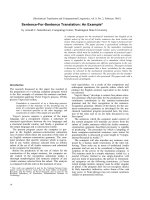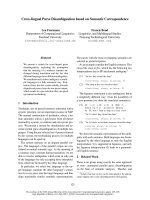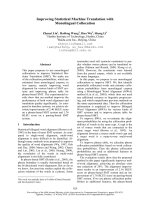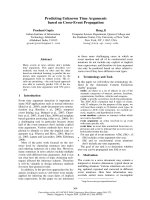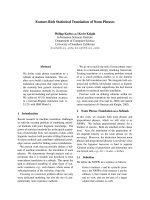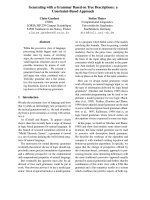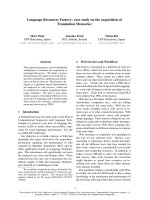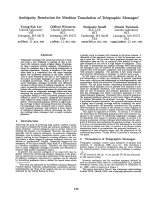Báo cáo khoa học: "English-Chinese Bi-Directional OOV Translation based on Web Mining and Supervised Learning" pot
Bạn đang xem bản rút gọn của tài liệu. Xem và tải ngay bản đầy đủ của tài liệu tại đây (328.47 KB, 4 trang )
Proceedings of the ACL-IJCNLP 2009 Conference Short Papers, pages 129–132,
Suntec, Singapore, 4 August 2009.
c
2009 ACL and AFNLP
English-Chinese Bi-Directional OOV Translation
based on Web Mining and Supervised Learning
Yuejie Zhang, Yang Wang and Xiangyang Xue
School of Computer Science
Shanghai Key Laboratory of Intelligent Information Processing
Fudan University, Shanghai 200433, P.R. China
{yjzhang,072021176,xyxue}@fudan.edu.cn
Abstract
In Cross-Language Information Retrieval
(CLIR), Out-of-Vocabulary (OOV) detection
and translation pair relevance evaluation still
remain as key problems. In this paper, an Eng-
lish-Chinese Bi-Directional OOV translation
model is presented, which utilizes Web mining
as the corpus source to collect translation pairs
and combines supervised learning to evaluate
their association degree. The experimental re-
sults show that the proposed model can suc-
cessfully filter the most possible translation
candidate with the lower computational cost,
and improve the OOV translation ranking ef-
fect, especially for popular new words.
1 Introduction
In Cross-Language Information Retrieval (CLIR),
most of queries are generally composed of short
terms, in which there are many Out-of-
Vocabulary (OOV) terms like named entities,
new words, terminologies and so on. The transla-
tion quality of OOVs directly influences the pre-
cision of querying relevant multilingual informa-
tion. Therefore, OOV translation has become a
very important and challenging issue in CLIR.
The translation of OOVs can either be ac-
quired from parallel or comparable corpus (Lee,
2006) or mining from Web (Lu, 2004). However,
how to evaluate the degree of association be-
tween source query term and its target translation
is quite important. In this paper, an OOV transla-
tion model is established based on the combina-
tion pattern of Web mining and translation rank-
ing. Given an OOV, its related information are
gotten from search results by search engine, from
which the possible translation terms in target
language can be extracted and then ranked
through supervised learning such as Support
Vector Machine (SVM) and Ranking-SVM (Cao,
2006). The basic framework of the translation
model is shown in Figure 1.
Figure 1. The basic framework of English-
Chinese Bi-Directional OOV translation model.
2 Related Research Work
With the rapid growth of Web information, in-
creasing new terms and terminologies cannot be
found in bilingual dictionaries. The state-of-art
OOV translation strategies tend to use Web itself
as a big corpus (Wang, 2004; Zhang, 2004). The
quick and direct way of getting required informa-
tion from Web pages is to use search engines,
such as Google, Altavista or Yahoo. Therefore,
many OOV translation models based on Web
mining are proposed by researchers (Fang, 2006;
Wu, 2007).
By introducing supervised learning mechan-
ism, the relevance between original OOV term
and extracted candidate translation can be accu-
rately evaluated. Meanwhile, the model proposed
exhibits better applicability and can also be ap-
plied in processing OOVs with different classes.
3 Chinese OOV Extraction based on
PAT-Tree
For a language that has no words boundary like
Chinese, PAT-Tree data structure is adopted to
extract OOV terms (Chien, 1997). The most out-
standing property of this structure is its Semi
Infinite String, which can store all the semi-
strings of whole corpus in a binary tree. In this
tree, branch nodes indicate direction of search
129
and child nodes store information about index
and frequency of semi infinite strings. With
common strings being extracted, large amounts
of noisy terms and fragments are also extracted.
For example, when searching for the translation
of English abbreviation term “FDA”, some noisy
Chinese terms are extracted, such as “国食品”
(17 times), “美国食品” (16 times), “美国食品
药” (9 times). In order to filter noisy fragments,
the simplified Local-Maxima algorithm is used
(Wang, 2004).
4 Translation Ranking based on Super-
vised Learning
4.1 Ranking by Classification and Ordinal
Regression
Based on the extracted terms, the correct transla-
tion can be chosen further. A direct option is to
rank them by their frequency or length. It works
well when the OOV term has a unique meaning
and all the Web snippets are about the same topic.
However, in much more cases only the highly
related fragments of OOV terms can be found,
rather than their correct translations. To evaluate
the relevance of translation pair precisely, SVM
and Ranking-SVM are employed as classifier
and ordinal regression model respectively.
4.2 Feature Representation
The same feature set is utilized by SVM and
Ranking-SVM.
(1) Term frequency: f
q
denotes the frequency of
OOV to be translated in all the Web snippets
of search results. tf
i
indicates the number of
the translation candidate in all the snippets.
df
i
represents the number of Web snippets
that contains the candidate. df
t
means the
number of snippets that contains both OOV
to be translated and the candidate.
(2) Term length: Len( ) is the length of the can-
didate.
(3) Cooccurrence Distance: C-Dist is the aver-
age distance between the OOV query and the
translation candidate, computed as follows.
()
-
t
Sum Dist
CDist
df
=
(1)
where Sum(Dist) is the sum of distance in
each translation pair of every snippet.
(4) Length Ratio: This is the ratio of OOV query
length and translation candidate length.
(5) Rank Value:
i. Top Rank (T-Rank): The rank of snippet
that first contains the candidate. This
value indicates the rank given by search
engine.
ii. Average_Rank (A-Rank): It is the aver-
age position of candidate in snippets of
search results, shown as follows.
()
idf
RankSum
RankA =−
(2)
where Sum(Rank) denotes the sum of
every single rank value of snippets that
contains the candidate.
iii. Simple_Rank (S-Rank): It is computed
based on Rank(i)=tf
i
*Len(i), which aims
at investigating the impact of these two
features on ranking translation.
iv. R-Rank: This rank method is utilized as a
comparison basis, computed as follows.
()
OOV
n
n
f
f
L
S
RankR ×−+×=−
αα
1
(3)
where α is set as 0.25 empirically, |S
n
|
represents the length of candidate term,
L is the largest length of candidate terms,
f
n
is tf
i
, and f
oov
is f
q
in Feature (1).
v. Df_Rank (D-Rank): It is similar to S-
Rank and computed based on Rank(i)=
df
i
*Len(i).
(6) Mark feature: Within a certain distance
(usually less than 10 characters) between the
original OOV and candidate, if there is such
a term like “全称”, “中文叫”, “中文译为”,
“中文名称”, “中文称为”, “或称为”, “又称
为”, “英文叫”, “英文名为”, this feature will
be labeled as “+1”, else “-1” instead.
Among these features above, some features
come from search engine like (1) and (5) and
some ones from heuristic rules like (3) and (6).
Through the establishment of feature set, the
translation candidate can be optimized efficiently
and the noisy information can also be filtered.
5 Experiment and Analysis
5.1 Data Set
For the performance evaluation of Chinese-
English OOV translation, the corpus of NER task
in SIGHAN 2008 provided by Peking University
is used. The whole corpus contains 19,866 per-
son names, 22,212 location names and 7,837 or-
ganization names, from which 100 person names,
100 location names and 100 organization names
are selected for testing. Meanwhile, 300 English
named entities are chosen randomly from the
terms of 9 categories, which include movie name,
book title, organization name, brand name, ter-
minology, idiom, rare animal name, person name
130
and so on. These new terms are used as the test-
ing data for English-Chinese OOV translation.
5.2 Evaluation Metrics
Three parameters are used for the evaluation of
translation and ranking candidates.
translatedbetotermsOOVofnumbertotal
nstranslatioNtopinntranslatiocorrectofnumber
RateInclusionN
=
−−
(4)
()
translatedbetotermfornstranslatiocorrectofnumber
nstranslatioRtopinntransaltiocorrectofnumber
termecisionPrR
i
i
=
−
(5)
()
translatedbetotermsOOVofnumbertotal
termecisionPrR
ecision
Pr
R
T
i
i
∑
=
−
=
−
1
(6)
where T denotes the number of testing entities.
The first one is a measurement for translation
and the others are used for ranking measurement.
5.3 Experiment on Parameter Setting
Frequency and length are two crucial features for
translation candidates. To get the most related
terms into top 10 before the final ranking, a pre-
rank testing is performed based on S-Rank, R-
Rank and D-Rank. It can be seen from Figure 2
that the pre-rank by D-Rank exhibits better per-
formance in translation experiment.
Figure 2. The impact of different Pre-Rank man-
ners on English-Chinese OOV translation.
In search results, for some English OOV terms
such as “
BYOB(自带酒水)”, there are few candi-
dates with better quality in top 20 snippets.
Therefore, in order to find how many snippets
are suitable in translation, the experiment on
snippet number is performed. It can be observed
from Figure 3 that the best performance can be
obtained by utilizing 200 snippets.
Figure 3. The impact of different snippet number
on English-Chinese OOV translation.
5.4 Experiment On English-Chinese Bi-
Directional OOV Translation
The experimental results on 300 English new
terms are shown in Table 1.
N-Inclusion-Rate
English-Chinese OOV
Translation
Top-1
0.313
Top-3
0.587
Top-5
0.627
Top-7
0.707
Top-9
0.763
Table 1. The experimental results on English-
Chinese OOV translation.
The experimental results on 300 Chinese
named entities are shown in Table 2.
N-Inclusion-
Rate
Person
Name
Location
Name
Organization
Name
Top-1
0.210 0.510 0.110
Top-3
0.390 0.800 0.280
Top-5
0.490 0.900 0.400
Top-7
0.530 0.920 0.480
Top-9
0.540 0.930 0.630
Table 2. The experimental results on Chinese-
English OOV translation.
It can be observed from Table 2 that the per-
formance of Chinese location name translation is
much higher than the other two categories. This
is because most of the location names are famous
cities or countries. The experimental results
above demonstrate that the proposed model can
be applicable in all kinds of OOV terms.
5.5 Experiment on Ranking
In SVM-based and Ranking-SVM-based ranking
experiment, the statistics on training data are
shown in Table 3. For SVM training data, the
“Related” candidates are neglected. The experi-
mental results on ranking in English-Chinese and
Chinese-English OOV translation are shown in
Table 4 and 5 respectively.
Number of
Candidates
Correct Related Indifferent
English-
Chinese
234 141 250
Chinese-
English
240 144 373
Table 3. Statistics of training data for ranking.
English-
Chinese
Top-1
Inclusion
Top-3
Inclusion
R-
Precision
D-Rank
0.313 0.587 0.417
T-Rank
0.217 0.430 0.217
SVM
0.530 0.687 0.533
Ranking-SVM 0.550 0.687 0.547
Table 4. The experimental results on ranking in
English-Chinese OOV translation.
131
Chinese-
English
Top-1
Inclusion
Top-3
Inclusion
R-
Precision
TF-Rank
0.277 0.490 0.287
T-Rank
0.197 0.387 0.207
SVM
0.347 0.587 0.347
Ranking-SVM 0.357 0.613 0.387
Table 5. The experimental results on ranking in
Chinese-English OOV translation.
From the experiments above, it can be con-
cluded that the supervised learning significantly
outperform the conventional ranking strategies.
5.6 Analysis and Discussion
Through analysis about the experimental results
in extraction and ranking, it can be observed that
the OOV translation quality is highly related to
the following aspects.
(1) The translation results are related to the
search engine used, especially for some spe-
cific OOV terms. For example, given a query
OOV term “两岸三通”, the mining result
based on Google in China is “three direct
links”, while some meaningless information
is mined by the other engines like Live Trans.
(2) Some terms are conventional terminologies
and cannot be translated literally. For exam-
ple, “
woman pace-setter”, a proper name with
the particular Chinese characteristic, should
be translated into “三八红旗手”, rather than
“女子的步伐” or “制定”.
(3) The proposed model is sensitive to the nota-
bility degree of OOV term. For famous per-
son name and book title, the translation per-
formance is very promising. However, for
other OOV terms with lower notability, such
as “贝尔曼来” and “兰红光”, the correct
translation cannot even be retrieved by
search engine.
(4) Word Sense Disambiguation (WSD) should
be added to improve the whole translation
performance. Although most of OOVs have
unique semantic definition, there are still a
few OOVs with ambiguity. For example,
“Rice” can either be a person name or a kind
of food. Another example is “AARP”, which
also has two kinds of meaning, that is, “美国
退休者协会” and “地址解析协议”.
6 Conclusions and Future Work
In this paper, the proposed model improves the
acquirement ability for OOV translation through
Web mining and solves the translation pair eval-
uation problem in a novel way by introducing
supervised learning in translation ranking. In ad-
dition, it is very significant to apply the key
techniques in traditional machine translation into
OOV translation, such as OOV recognition, sta-
tistical machine learning, alignment of sentence
and phoneme, and WSD. The merits of these
techniques should be integrated. All these as-
pects above will become the research focus in
our future work.
Acknowledgments
This paper is supported by National Natural
Science Foundation of China (No. 60773124),
National Science and Technology Pillar Program
of China (No. 2007BAH09B03) and Shanghai
Municipal R&D Foundation (No. 08dz1500109).
Yang Wang is the corresponding author.
References
Chun-Jen Lee, Jason S. Chang, and Jyh-Shing R. Jang.
2006. Alignment of Bilingual Named Entities in
Parallel Corpora Using Statistical Models and
Multiple Knowledge Sources. ACM Transactions
on Asian Language Processing, 5(2):121-145.
Gaolin Fang, Hao Yu, and Fumihito Nishino. 2006.
Chinese-English Term Translation Mining Based
on Semantic Prediction. In Proceedings of the
COLING/ACL on Main Conference Poster Ses-
sions, pp.199-206.
Jenq-Haur Wang, Jei-Wen Teng, Pu-Jen Cheng, Wen-
Hsiang Lu, and Lee-Feng Chien. 2004. Translating
Unknown Cross-Lingual Queries in Digital Libra-
ries Using a Web-based Approach. In Proceedings
of the 4
th
ACM/IEEE-CS Joint Conference on Dig-
ital Libraries, pp.108-116.
Jian-Cheng Wu and Jason S. Chang. 2007. Learning
to Find English to Chinese Transliterations on the
Web. In Proceedings of the 2007 Joint Conference
on Empirical Methods in Natural Language
Processing and Computational Natural Language
Learning, pp.996-1004.
L. F. Chien. 1997. PAT-Tree-Based Keyword Extrac-
tion for Chinese Information Retrieval. In Proceed-
ings of SIGIR’97, pp.50-58.
Wen-Hsiang Lu and Lee-Feng Chien. 2004. Anchor
Text Mining for Translation of Web Queries: A
Transitive Translation Approach. ACM Transac-
tions on Information Systems, 22(2): 242-269.
Ying Zhang and Phil Vines. 2004. Detection and
Translation of OOV Terms Prior to Query Time. In
Proceedings of SIGIR’04, pp.524-525.
Yunbo Cao, Jun Xu, Tie-Yan LIU, Hang Li, Yalou
HUANG, and Hsiao-Wuen HON. 2006. Adapting
Ranking SVM to Document Retrieval. In Proceed-
ings of SIGIR’06, pp.186-193.
132
